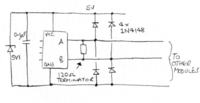prakash12346
Newbie level 5

We have a circuit which master RS 485 module is designed as fail safe mode and (DC GND) connected directly to Earth. It communicates to other RS 485 modules in daisy chain connection with/ with out end node termination & this modules are connected (DC GND) to earth via a RC in parallel network ( 100 R, 0.1 uf) . Now the 485 chip in master module is getting burnt after some days of communication. Can any one help me out what will be the issue. Whether earth is creating issue and if yes why it is.
Design attached for referenceView attachment case 4.pdfView attachment case 5.pdf.
Design attached for referenceView attachment case 4.pdfView attachment case 5.pdf.




